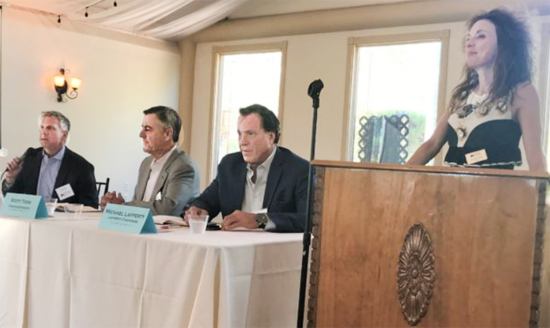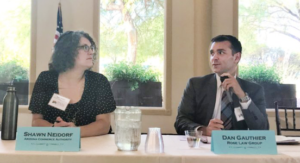
Disclosure: Rose Law Group represents Defer Gain
By Callan Smith | Rose Law Group Reporter
Opportunity zones, how they work and how to invest was the topic of discussion at Pinal Partnership’s monthly breakfast panel, moderated by Jordan Rose, Rose Law Group president and founder.
The zones are a federal community development program enacted as part of the Tax Cuts and Jobs Act, passed in December of 2017, with the primary purpose of incentivizing long-term investment in zones set aside by each state. Arizona has 168 Opportunity Zones, designated by Governor Ducey and certified in April.
Investors can participate by rolling unrealized capital gains into an opportunity fund, which can make a variety of investments in the designated zones with three primary incentives. If the gains are held by the fund for five years, the eventual tax on those gains is reduced by ten percent; if held for another two years, the eventual tax is reduced by an additional five percent. At ten years, the gain earned while the investment was in the opportunity fund – the difference between the original investment and its value ten years later—is untaxed.

“There is a potential for a huge impact across the country and in Pinal County,” Dan Gauthier an associate with Rose Law Group said.
In 2016, the Economic Innovation Group did a study that Gauthier cited, noting U.S. households had $2.3 trillion in unrealized capital gains in stocks and funds. In 2017, the number rose to $3.8 trillion, with U.S. corporations holding an estimated $2.3 trillion, all totaling $6.1 trillion with potential for investment in the program.
“If even a small portion of that gets rolled into these opportunity zones we’re looking at the biggest federal community development in history,” Gauthier said.
The Arizona Commerce Authority (ACA) used 2011 – 2015 Treasury survey data to determine which zones to designate, along with the 2012 – 2016 data. Following that the ACA went to the communities to get input and recommendations on which census tract to certify as an Opportunity Zone, including rural areas where critical infrastructure could be found, such as airports.
“The idea was to drive passive investment to active long-term investment into communities that would be potentially overlooked and not recovered well from the recession,” Shawn Neidorf, who oversaw efforts relating to Opportunity Zones and funds at the ACA, said.
Arizona was one of the first states to submit zones to the Treasury Department, Neidorf said, which happened quickly after the development of data and models.
The designation process was transparent compared to other states, Scott Tonn, co-founder and partner of Defer Gain, LLC, an Opportunity Zone investment fund, said.
Areas of Downtown Phoenix have been designated, which Defer Gain, will be taking advantage of, as they hold over $300 million in projects, which “are ready to go,” said Michael Lafferty, co-founder, and partner of Defer Gain.
“For those people that are in the capital gain situation, where they have an investment that they want to do something else with and unlock, there is now a place for that money to go that is not taxed immediately,” Tonn said.
At Defer Gain, their view is of real estate and real estate improvement, followed by business investment into Opportunity Zones, which would bring job creation into neighborhoods.
“There is some very exciting things that are going to happen to change the landscape of cities, towns, neighborhoods over the next ten years,” Tonn said.
Most of the tax code is structured around tax deferral code, such as 1031 Exchange, whereas long-term investment of capital gains into Opportunity Zones creates a tax exclusion scenario, Joshua Hayes, tax advisor, a partner at Eide Bailly, said
“From a tax planners perspective, this is a dream come true,“ Hayes said.
Corrections are coming from the Treasury Department to clear up uncertainties, including the question of capital gain versus gain, which is a matter of wording.
“Overall, while there is some uncertainty, Congress did a good job in laying the framework, which is why we see these funds being set up now is because we have enough to start with, “Gauthier said.
For more information, there is an Opportunity Zones and Opportunity Funds conference in Tempe on September 27th, 2018.











